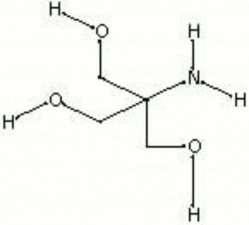Difference between revisions of "Tris(hydroxymethyl)aminomethane"
Jump to navigation
Jump to search
(username removed) |
|||
| (3 intermediate revisions by 2 users not shown) | |||
| Line 1: | Line 1: | ||
== Description == | == Description == | ||
| + | [[[SliderGallery rightalign|tris(hydroxymethyl)aminomethane.jpg~Chemical structure]]] | ||
| + | White, crystalline solid. Tris(hydroxymethyl)aminomethane is used as an emulsifying agent for oils, fats and waxes. It is also mixed in equally proportions with its corresponding hydrochloric acid salt and used as a buffer (see [[Trizma|Trizma]]). | ||
| − | + | == Synonyms and Related Terms == | |
| − | + | tris; tris hydroxymethyl aminomethane; THAM; 2-amino-2-hydroxymethyl-1,3-propanediol; tris amine buffer; | |
| − | + | == Risks == | |
| − | [ | + | * Combustible. |
| + | * Corrosive to copper, brass, aluminum. | ||
| + | * Harmful by ingestion and inhalation. | ||
| + | * Skin contact causes irritation and burns. | ||
| + | * MerckMillipore: [https://www.emdmillipore.com/US/en/product/msds/MDA_CHEM-108386 SDS] | ||
| − | == | + | ==Physical and Chemical Properties== |
Soluble in water (pH = 10.36 for 0.1 M solution). | Soluble in water (pH = 10.36 for 0.1 M solution). | ||
| Line 22: | Line 28: | ||
|- | |- | ||
! scope="row"| Melting Point | ! scope="row"| Melting Point | ||
| − | | 171-172 | + | | 171-172 C |
|- | |- | ||
! scope="row"| Molecular Weight | ! scope="row"| Molecular Weight | ||
| Line 28: | Line 34: | ||
|- | |- | ||
! scope="row"| Boiling Point | ! scope="row"| Boiling Point | ||
| − | | 219-220 | + | | 219-220 C |
|} | |} | ||
| − | == | + | ==Resources and Citations== |
| − | |||
| − | |||
| − | |||
| − | |||
| − | |||
| − | |||
| − | |||
| − | |||
| − | * | + | * Richard S. Lewis, ''Hawley's Condensed Chemical Dictionary'', Van Nostrand Reinhold, New York, 10th ed., 1993 |
| − | * | + | * Richard C. Wolbers, Nanette T. Sterman, Chris Stavroudis, ''Notes for Workshop on New Methods in the Cleaning of Paintings'', J.Paul Getty Trust, Los Angeles, 1990 |
[[Category:Materials database]] | [[Category:Materials database]] | ||
Latest revision as of 15:39, 16 June 2022
Description
White, crystalline solid. Tris(hydroxymethyl)aminomethane is used as an emulsifying agent for oils, fats and waxes. It is also mixed in equally proportions with its corresponding hydrochloric acid salt and used as a buffer (see Trizma).
Synonyms and Related Terms
tris; tris hydroxymethyl aminomethane; THAM; 2-amino-2-hydroxymethyl-1,3-propanediol; tris amine buffer;
Risks
- Combustible.
- Corrosive to copper, brass, aluminum.
- Harmful by ingestion and inhalation.
- Skin contact causes irritation and burns.
- MerckMillipore: SDS
Physical and Chemical Properties
Soluble in water (pH = 10.36 for 0.1 M solution).
| Composition | (CH2OH)3CNH2 |
|---|---|
| CAS | 77-86-1 |
| Melting Point | 171-172 C |
| Molecular Weight | mol. wt. = 121.14 |
| Boiling Point | 219-220 C |
Resources and Citations
- Richard S. Lewis, Hawley's Condensed Chemical Dictionary, Van Nostrand Reinhold, New York, 10th ed., 1993
- Richard C. Wolbers, Nanette T. Sterman, Chris Stavroudis, Notes for Workshop on New Methods in the Cleaning of Paintings, J.Paul Getty Trust, Los Angeles, 1990
